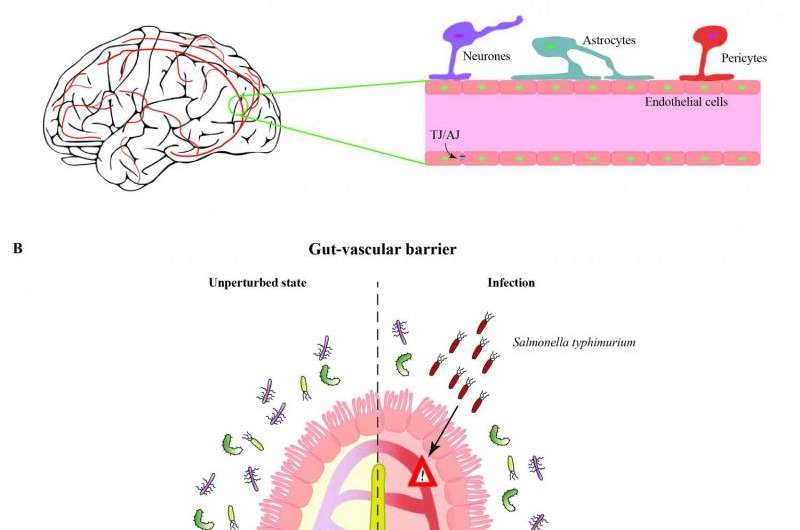November 13, 2015 report
How salmonella manage to sometimes pass through the gut-vascular barrier in mice

(Medical Xpress)—A team of researchers from several institutions in Italy has discovered the mechanism by which Salmonella typhimurium is sometimes able to trick the gut-vascular barrier (GVB) in mice, into allowing it to pass into the bloodstream. In their paper published in the journal Science, the team describes how they identified the means by which S. typhimurium is able to make its way through both the intestinal epithelium and the vascular barrier allowing for infecting other organs such as the spleen, liver and gall bladder. Romain Bouziat and Bana Jabri with the University of Chicago offer a Perspectives piece on the work done by the team in the same journal issue.
To allow food to pass from the intestines into the bloodstream, but not bacteria or viruses, the mouse gut has two layers of protection, the first is the epithelium layer that forms the walls of the intestines, it is a group of cells that grow tightly packed together, like a brick wall that allows only very tiny particles to pass through. The next layer, known as the vascular barrier, is similar, the team reports, to the blood-brain barrier, both in makeup and function. They took a closer look at the similarities and differences between the two barrier types as a means of trying to understand how it is that some bacteria such as salmonella, manage to make their way through. They found that while the two barriers behave in much the same way, the intestinal barrier allowed particles eight times larger than the blood-brain barrier to pass through. They also noted signaling is used in both as a means of allowing or barring material from passing through—it was that signaling, the team found, that allowed a salmonella bacterium to pass through—it did so by causing a decrease in β-catenin signaling, which provided a pass to move freely through the barrier. Interestingly, the team noted that while still in the intestine, the same type of bacteria caused an increase in β-catenin signaling which allowed it to disseminate throughout the gut.
The group notes that it appears that if a means could be found to prevent salmonella from decreasing signaling in the barrier, it could mean constraining such infections to the gut—treatments could be introduced along with antibiotics to lessen the impact of infections.
More information: I. Spadoni et al. A gut-vascular barrier controls the systemic dissemination of bacteria, Science (2015). DOI: 10.1126/science.aad0135
Abstract
In healthy individuals, the intestinal microbiota cannot access the liver, spleen, or other peripheral tissues. Some pathogenic bacteria can reach these sites, however, and can induce a systemic immune response. How such compartmentalization is achieved is unknown. We identify a gut-vascular barrier (GVB) in mice and humans that controls the translocation of antigens into the blood stream and prohibits entry of the microbiota. Salmonella typhimurium can penetrate the GVB in a manner dependent on its pathogenicity island (Spi) 2–encoded type III secretion system and on decreased β-catenin–dependent signaling in gut endothelial cells. The GVB is modified in celiac disease patients with elevated serum transaminases, which indicates that GVB dismantling may be responsible for liver damage in these patients. Understanding the GVB may provide new insights into the regulation of the gut-liver axis.
© 2015 Medical Xpress


















